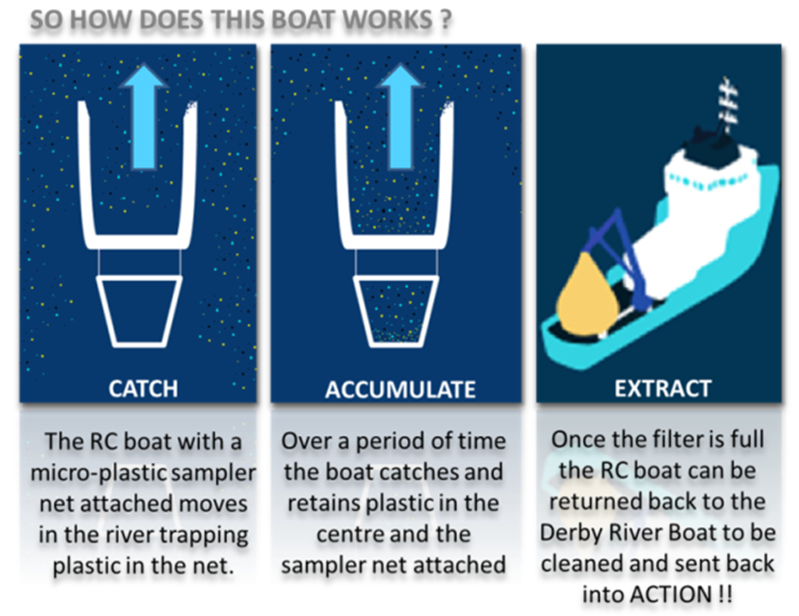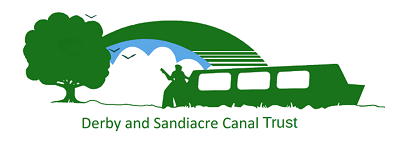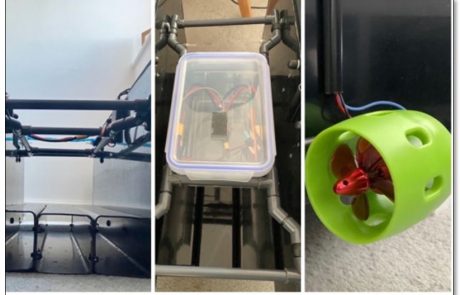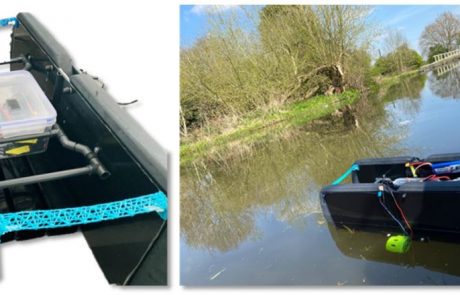ARTEMIS – “Aquatic Remote Technology Environmental Mitigation (and) Intercept System”
#Cleaner Rivers: Now and Forever
Article submitted by Archit Sharma, Technical Owner for ARTEMIS (Manufacturing Engineer at Rolls-Royce).
Back in 2019, the Derby & Sandiacre Canal Trust (DSCT) started construction of the Derby Riverboat project (now known as “Outram“), an all-electric narrowboat. Outram has now completed construction and outfitting in March 2021, and is waiting transfer onto the River Derwent. It was realised that the Trust could use this opportunity to develop a project that can help in spreading awareness about water pollution caused by micro/macro plastics from our local rivers; and that’s how the idea of ARTEMIS was born!
ARTEMIS is a radio controlled boat and is entrusted to execute its vision of Cleaner Rivers – Now & Forever. The aim of this project is two fold:
- A Made in UK, radio controlled boat that can be deployed to collect micro & macro plastics from local water bodies.
- To become a coveted STEM program that can demonstrate the role Science & Technology can play in fighting water pollution.
That’s when Michael Wingfield, who is both a Trustee with the DSCT and a Measurement Technologist at Rolls-Royce in Derby, led the challenge with a team of 4 graduate manufacturing engineers at Rolls-Royce to design, manufacture and test a prototype of a radio-controlled boat that can filter micro & macro plastics from freshwater river ecosystems; in particular the river Derwent in Derbyshire.

The Design
The boat was designed to consist of adjoined dual hulls made from non-degradable plastic, with both a plastic collection system employed on-board. Micro & macro plastics will be collected from the water’s surface using the space between the hull sections as a “mouth” and a collection guard, to stop floating plastic escaping. The boat is intended to be stored and launched into the River Derwent whilst aboard Outram – with the boat being radio controlled by our volunteers and potentially those aboard the vessels.

The team did a stunning job with the design and reached out to ‘CREATE Edu.’ to help 3D print a prototype that could be trialled further.
I (Archit) joined the team in early 2020 as a Technical Owner for ARTEMIS shortly after the team handed the project to the trust, but just then COVID-19 hit! The project suffered massive delays and it wasn’t until August 2020 that we received the 3D printed prototype. It wasn’t just the delay that caused problems but upon closer inspection there were some serious quality issues that posed some serious risks to the usability of this boat. At that point we could either think about salvaging the boat or start fresh with an improved design – it was the latter that we decided to go with. With the entire country going through yet another lockdown towards the end of 2020, it was sensible to rely on common items found easily to have a shot at building ARTEMIS based on a revised design.
Keeping the previous dual hull system in mind, we used swimming floats to create the hulls and secured them using acrylic sheets. The Hulls were secured using square tubing that will also allow the water to pass through and filter any micro-macro plastic using an appropriate sieving mechanism. The next challenge we were facing was to put together the controls for the boat. This is when we sought support from Dave Fillingham, a retired Rolls-Royce employee, who excels in building radio controlled objects as a hobby.
Once the controls were put together and tested, I put together a cross frame using ½ inch PVC pipe that not only secure the hulls from the top but also helped house the controls. The controls were housed in a sealed lunch-box that served its purpose much more effectively than previously anticipated. Dave later helped finish off the controls ready for the big day when we took ARTEMIS for its first ride!
Sea Trials
On a sunny Sunday last month this year, we took ARTEMIS to the Trent Lock in Weston for trials and to our delight it was successful in its maiden cruise. The trials were critical in establishing our understanding of ARTEMIS. The 12V Lithium Polymer (LiPo) battery provides a max draw current of 7Amp and it felt like a lot of thrust was available for the purpose of running ARTEMIS in the Derwent River later this year. ARTEMIS had a turning radius of approx. 3m, which is something the team will look at improving without compromising the overall dimensions.
One of the issues that came into light was the clogging of the thrusters from grass & weed. We look to resolve the issue in the future with custom 3D printed guarding for the thrusters. Overall it was a major milestone for the team to have demonstrated the basic capability of ARTEMIS and now look forward to carry out further trials with the filter mechanism in place.
Improving the Design
With basic capability proven, we are planning the next phase of work focused on maturing the design and the build quality of ARTEMIS. Technologies like LIDAR & GPS can help ARTEMIS become fully autonomous, with build in sensors to navigate its surrounding. Advancements in 3D printing will not only help print custom complex parts & housing units but also keep costs down. We are working closely with the University of Derby to further improve our design and help commercialise the plastic collection boat.
So, what is it that I reflect from this project so far? Mainly 2 things: –
- It is still not too late to join the global fight against pollution and contribute in its cause in any shape or form possible.
- Science & Technology continue to play a pivotal role in combating pollution and with STEM education, we can enable the next generation of critical thinkers and innovators to continue making our world a better place to live.
I finish this post with a quote from Sir David Attenborough:
“We are at a unique stage in our history. Never before have had such an awareness of what we are doing to the planet, and never before have we had the power to do something about that”.
By sharing with you ARTEMIS’s story, we hope to have sparked some curiosity & thoughts about our mission. Please get in touch at riverprojects@derbycanal.org.uk if you would like to know more or become a part of this exciting journey.
Please Note: Derby & Sandiacre Canal Trust owns the design rights and title of the remote controlled boat.



